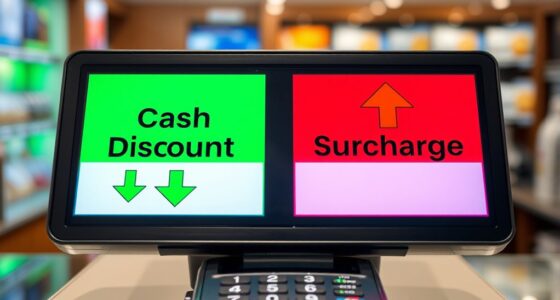A merchant account is a special bank account that holds your funds after a sale, while a payment gateway securely transmits your customers’ payment details online. The payment processor connects with banks and card networks to approve transactions and transfer funds. Although they work together seamlessly, each plays a distinct role in processing payments. Understanding these differences helps you set up a smooth payment system—continue to explore for a clearer picture.
Key Takeaways
- A merchant account is a bank account that holds funds temporarily from card transactions, while a payment gateway securely transmits payment data online.
- The payment processor authorizes transactions by connecting to banks and card networks, facilitating fund transfers from the customer to the merchant.
- A payment gateway acts as the online point-of-sale, encrypting customer payment details and initiating transaction authorization.
- Merchant accounts are managed by financial institutions, whereas gateways and processors are technology providers that enable and facilitate payments.
- All three components work together to ensure secure, seamless, and efficient electronic payment processing for businesses.

When setting up online or in-store payment systems, understanding the roles of merchant accounts, payment gateways, and processors is essential. These components work together to enable smooth and secure transactions, but each serves a distinct purpose. Knowing the difference helps you choose the right setup for your business and ensures your customers have a seamless checkout experience.
A merchant account is a specialized bank account that allows you to accept and process card payments. When a customer makes a purchase, the funds are first received into this account and held temporarily until they’re transferred to your main business account. You need to establish a merchant account through a financial institution, which may involve an approval process and underwriting to assess your business’s risk. Think of it as a holding area for your funds before they land in your business bank account, ensuring you can manage and reconcile payments efficiently. It is typically provided by acquiring banks or specialized financial institutions.
A merchant account is a dedicated bank account for processing and managing card payments securely.
The payment gateway acts like an online point-of-sale system, transmitting sensitive payment data securely between your customer, your business, and the payment processor. It encrypts customer information to protect it from potential breaches and reduces your PCI compliance scope by ensuring the data doesn’t touch your systems directly. You can integrate a payment gateway into your website, app, or point-of-sale system using APIs, plugins, or hosted solutions. Many providers offer quick deployment options, making it easier to get started. The gateway’s primary function is to initiate the transaction by capturing payment details at checkout and transmitting them securely for authorization.
The payment processor is the service that connects to card networks and banks to approve transactions, settle funds, and facilitate the transfer from the customer’s bank to your merchant account. It handles communication with issuing banks, manages batch settlements, and performs daily reconciliation. You often need a payment processor to complete the transaction cycle, and some providers offer integrated solutions that combine merchant accounts and gateways for streamlined setup. The processor also provides security features like fraud detection and chargeback management, helping protect your business and customers.
In a typical transaction, the payment gateway first captures and encrypts the payment details, then forwards this data to the payment processor. The processor contacts the appropriate banks and card networks to approve or decline the transaction. Upon approval, the processor settles the funds, which are then temporarily held in your merchant account before being transferred to your main business bank account. Understanding these roles clarifies how each component contributes to a secure, efficient transaction process, ensuring your customers experience smooth, trustworthy payments every time.
Frequently Asked Questions
Can a Business Have Multiple Payment Processors Simultaneously?
Yes, you can have multiple payment processors at the same time. Doing so boosts your transaction success rates by providing alternative routes if one processor declines a payment. It also reduces risks, cuts costs, and allows you to accept more payment types across different regions. However, managing multiple processors adds complexity, requiring careful routing rules, ongoing monitoring, and extra operational effort to guarantee everything runs smoothly and efficiently.
How Do Transaction Fees Differ Among Merchant Accounts, Gateways, and Processors?
Imagine juggling a thousand fees at once—that’s what differentiates transaction fees among merchant accounts, gateways, and processors. You’ll see merchant accounts charge a hefty interchange plus a small markup, gateways often hit you with flat or percentage fees per transaction, and processors bundle everything into simple flat rates or variable percentages. Each has its own fee rhythm, making it vital to understand who charges what and when, to keep costs in check.
Are There Specific Industries Better Suited for Certain Payment Solutions?
You’re wondering if certain industries are better suited for specific payment solutions. The answer is yes. High-volume, low-value sectors like retail benefit from fast, flat-rate processors. High-value industries such as luxury goods prefer tailored merchant accounts. Subscription services need gateways with recurring billing. Mobile businesses favor contactless payment options, while online industries require secure gateways with fraud prevention. Choosing the right solution depends on your industry’s transaction volume, size, and operational needs.
What Security Features Do Payment Gateways Typically Offer?
Payment gateways typically offer robust security features to protect your transactions. They use SSL/TLS protocols to encrypt data, ensuring it stays confidential. You’ll find tokenization that replaces sensitive info with secure tokens, reducing fraud risk. Multi-factor authentication, real-time fraud monitoring, and CVV verification further enhance security. Additionally, gateways comply with PCI DSS standards, maintain secure infrastructure, and conduct regular audits, keeping your payment data safe and your business protected from threats.
How Long Does It Take to Set up Each Component?
Think of setting up these components as building a complex puzzle. A merchant account can be activated in minutes for simple setups, but established businesses need 24-48 hours. Payment gateways take longer, from weeks to months, especially if custom-built. Payment processors can be ready in weeks if using off-the-shelf solutions. Overall, quick setups are possible, but larger, more secure systems require patience for thorough compliance and infrastructure development.
Conclusion
Now that you’ve navigated the nuances of merchant accounts, payment gateways, and processors, you can confidently craft your commerce castle. Remember, choosing the right combination creates a seamless, secure, and swift shopping experience. By balancing the backbone of your business with brilliant technology, you build a bustling bridge between buyer and seller. So, take charge, make clear choices, and watch your commerce castle conquer the e-commerce cosmos with confidence and clarity.









